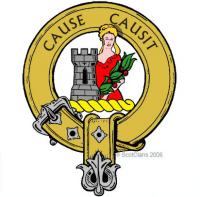
Clan Elphinstone
The family who took the name Elphinstone may have originated from the lands of Airth in Stirlingshire. They were called de Erths and erected a castle nearby and through marriage inherited lands near Tranent in East Lothian. These lands came to be known as Elphinstone. Deeds dating from 1235 from this area bear the name ‘de Elfinstun’ and grants dating from 1250 record the name John de Elphinstone as a witness.
Sir John de Elfinstun married Margaret of Seton who was a niece of Robert the Bruce.
William Elfinstun was appointed Bishop of Aberdeen in 1484, later Lord High Chancellor of Scotland. In 1494 he was honored by Pope Alexander VI for founding the university in Aberdeen. He designed Kings College which was completed in 1500 and left funds for the building of a bridge across the Dee. He moved to Edinburgh after the battle of Flodden in 1513 to assist with the rebuilding but died shortly afterwards. The terrible battle had not only taken the life of the king James IV but also William's cousin, Sir Alexander Elphinston, First Lord Elphinstone.
The second Lord, was killed at the Battle of Pinkie in 1547. The fourth Lord Elphinstone was a judge of the Supreme Court of Scotland and later Lord High Treasurer and the eleventh Lord became lieutenant governor of Edinburgh Castle.
George Keith Elphinstone, A younger brother of the eleventh lord followed a naval career where he served on vessels that protected British shipping on Americas eastern seaboard. He also served with distinction in actions at the Cape of Good Hope and rose to the rank of Admiral and later Viscount. He became Baron Keith of Banheath.
His nephew William George Keith Elphinstone, fought at the battle of Waterloo. He was later commander in chief of the Bengal army, where he ran into trouble leading the Afghan campaign in 1841. He was to be court martialled but died before the trial could begin. The 13th Lord had better fortune in asia as Governor of Madras.
The present chief is the 19th Lord Elphinstone.








